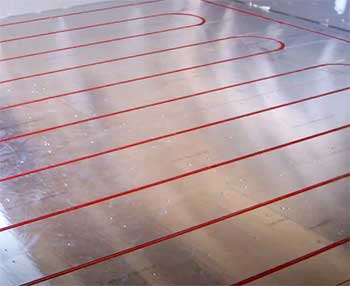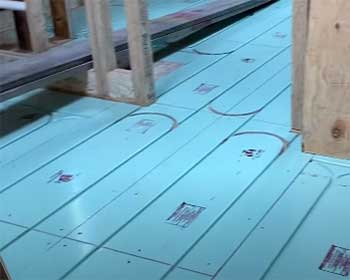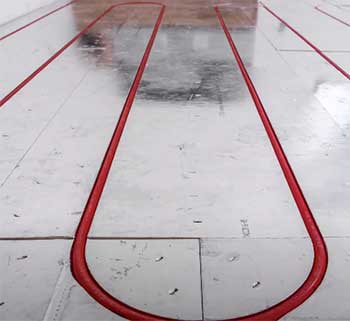When it comes to radiant heating, the market offers a wealth of options. Two systems that have caught the eyes of consumers are Ecowarm and Warmboard. Both have their strengths, but how do they stack up against each other?
Let’s dive into the details and demystify Ecowarm and Warmboard radiant heating systems.
A Brief Comparison Table
| Features | Ecowarm | Warmboard |
|---|---|---|
| Material and Construction | Made from recycled and sustainably sourced materials. Lightweight design with a low thermal mass. | Features a thick aluminum surface for superior heat conductivity. Heavier and robust in construction. |
| Installation | Easy and straightforward installation. Suitable for DIY. | More complex and detailed installation process. May require professional help. |
| Compatibility | Works with various flooring types but may have limitations. | Broad compatibility with different flooring types from hardwood and carpet to tile and stone. |
| Cost | Generally more affordable upfront due to lower material and installation costs. | Higher initial cost, but could be more cost-effective in the long run due to lower operational costs. |
| Environmental Impact | Emphasizes sustainability with use of recycled and sustainably sourced materials. | Doesn’t highlight eco-friendliness in material sourcing but is energy-efficient in operation. |
Ecowarm Radiant Heating: A Quick Overview

Ecowarm radiant heating has a reputation for providing efficient, cost-effective heating solutions.
One of its standout features is its eco-friendly nature, designed to minimize the environmental impact.
Let’s delve deeper into its benefits and drawbacks.
Pros of Ecowarm Radiant Heating
- Sustainability: Ecowarm takes pride in its eco-friendly approach. It uses recycled materials to manufacture its boards, ensuring a lower carbon footprint.
- Easy Installation: With its lightweight boards, installation of an Ecowarm system is generally easy and straightforward, reducing the labor cost.
- Energy Efficiency: Thanks to its low thermal mass, Ecowarm quickly responds to changes in the thermostat setting, increasing energy efficiency.
Cons of Ecowarm Radiant Heating
- Limited Distribution: Ecowarm’s distribution network is relatively small, potentially making it harder to purchase and obtain customer service in some regions.
- Noise: Some users have reported minor noise issues with Ecowarm systems.
Warmboard Radiant Heating: What’s It All About?

Warmboard, on the other hand, has established itself as a leader in the radiant heating industry, known for its high-quality, high-performing heating systems.
But what makes it stand out, and what are its potential pitfalls?
Pros of Warmboard Radiant Heating
- Excellent Heat Conductivity: Warmboard’s systems are crafted with a thick aluminum surface which provides outstanding heat conductivity.
- Lower Operational Cost: Warmboard operates at a lower water temperature compared to other systems, reducing the energy required to heat the water, and hence, decreasing operational costs.
- Superior Compatibility: It works well with any flooring type, offering more flexibility in design choices.
Cons of Warmboard Radiant Heating
- Installation Complexity: While the Warmboard system offers excellent performance, it requires a more complicated installation process, which could increase the initial investment.
- Higher Initial Cost: Warmboard radiant heating systems come with a higher upfront cost compared to Ecowarm and other competitors.
Key Differences Between Ecowarm And Warmboard Radiant Heating
While both Ecowarm and Warmboard offer radiant heating systems, they do have some distinct differences that set them apart. Let’s examine these key differentiators in detail.
- Material and Construction
Ecowarm is made from recycled and sustainably sourced materials, making it a greener option. The board is lightweight and designed with a low thermal mass, enabling quick response to thermostat changes.
Warmboard, conversely, features a thick aluminum surface, which increases its heat conductivity. The robust construction provides excellent heat transfer, ensuring an evenly heated surface.
- Installation
Ecowarm shines in its simplicity. Its light weight and straightforward design allow for easier and faster installation, making it a go-to for many DIY enthusiasts and professionals alike.
Warmboard requires a more detailed installation process due to its thick boards and intricate heating systems. This could mean additional labor costs but results in an extremely high-performing radiant heating solution.
- Compatibility
Warmboard boasts a broad range of compatibility with different flooring types, from hardwood and carpet to tile and stone, offering more flexibility for your interior design.
Ecowarm, while also versatile, may have certain limitations with specific flooring types due to its construction. Always double-check with the manufacturer or your flooring provider to ensure compatibility.
- Cost

When it comes to cost, Ecowarm often comes out as the more affordable option upfront, given its lower material and installation costs.
This makes it an attractive choice for homeowners working within a budget.
Warmboard, while carrying a higher initial cost, can offer lower operational costs over time due to its high energy efficiency and exceptional heat conductivity.
This could make it a more cost-effective option in the long run for some homeowners.
- Environmental Impact
Ecowarm sets itself apart with its commitment to sustainability. The use of recycled and sustainably sourced materials in its construction greatly reduces its environmental footprint.
While Warmboard doesn’t highlight the same level of eco-friendliness in its material sourcing, its energy-efficient operation contributes to environmental conservation in the long term by reducing energy usage.
So, the key differences between Ecowarm and Warmboard radiant heating lie in their material and construction, installation process, flooring compatibility, cost, and environmental impact. Your choice between the two should consider these factors in conjunction with your specific needs and circumstances.
Frequently Asked Questions (FAQ)
The cost of Ecowarm can vary depending on the region and specifics of the installation, but you can expect a ballpark figure of around $10 to $12 per square foot, including materials and labor.
Quik Trak is a system that’s designed to be installed on top of an existing floor, making it a popular choice for retrofit projects. Warmboard, in contrast, is often used in new constructions due to its thickness and need for a more complex installation.
Aside from Ecowarm, other competitors of Warmboard include Uponor, Schluter-Systems, and ThermoSoft.
While many factors can influence the energy efficiency of a heated floor, Warmboard is often highlighted for its energy efficiency due to its lower operational temperature and superior heat conductivity.
Wrapping Up
Both Ecowarm and Warmboard radiant heating offer unique benefits to homeowners. Ecowarm impresses with its environmental friendliness and easy installation, while Warmboard stands out for its excellent heat conductivity and energy efficiency.
However, they also come with their own challenges, such as Ecowarm’s limited distribution and Warmboard’s higher initial cost. Therefore, the decision between Ecowarm and Warmboard will depend on your specific needs, budget, and sustainability goals.
In the ever-evolving world of radiant heating, it’s crucial to stay informed about the latest trends and technologies. Whether you choose Ecowarm, Warmboard, or another option altogether, you’re taking a step towards a more comfortable, energy-efficient home.
Stay warm and green!

Hi Raph, great Blog!
Doesn’t the Ecowarm also have an aluminum skin?